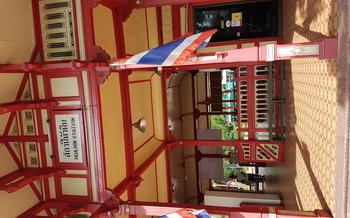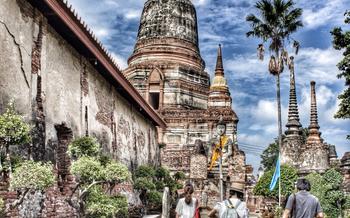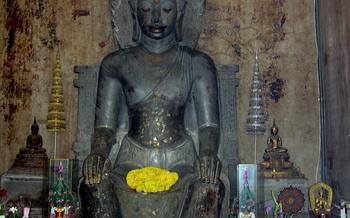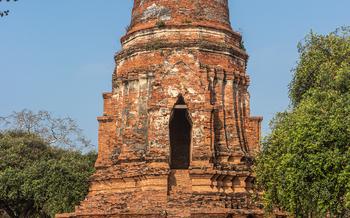
Wat Srapleng
- Wat Srapleng Temple: A Stunning Historical Marvel
- Exploring the Ubosot: Where Sacred Murals Reside
- Marveling at the Grand Buddha Image
- Discovering the Surrounding Temples and Shrines
- Witnessing the Vibrant Monks' Quarters
- Participating in Spiritual Ceremonies and Festivals
- Exploring the Local Market: A Culinary and Cultural Adventure
- Visiting the Elephant Village: A Touching Encounter
- Unleashing Your Inner Artist at the Ceramic Village
- Cooling Off at Kaeng Sopha Waterfall
- Shopping for Souvenirs and Local Products
- Local Markets and Shops
- Bargaining Tips and Tricks
- Supporting the Local Economy
- Finding Unique Gifts and Mementos
- Getting to Wat Srapleng: Transportation Options
- Accommodation Options Near Wat Srapleng
- Insider Tip: Uncovering Hidden Gems
Wat Srapleng Temple: A Stunning Historical Marvel
Standing tall as a testament to Thailand's rich cultural heritage, Wat Srapleng Temple, also known as Wat Srapreuk, captivates visitors with its architectural splendor and spiritual significance. Built in the 14th century, the temple holds a prominent place in the history of Phitsanulok, serving as a royal temple during the Ayutthaya Kingdom.
Throughout the centuries, Wat Srapleng has undergone several renovations and expansions, reflecting the evolving artistic styles and beliefs of the time. Its unique architectural features, including intricate carvings, graceful stupas, and elegant ordination halls, exemplify the fusion of traditional Thai and Khmer influences.
Beyond its historical significance, Wat Srapleng is a vibrant center of religious devotion. Locals and pilgrims alike flock to the temple to pay homage to the sacred Buddha images, offer prayers, and participate in various religious ceremonies and festivals throughout the year.
As you step into the temple grounds, you'll be enveloped in a serene and spiritual atmosphere, inviting you to immerse yourself in the rich tapestry of Thai culture and embrace the profound teachings of Buddhism.
Exploring the Ubosot: Where Sacred Murals Reside
The Ubosot, or ordination hall, of Wat Srapleng is a sanctuary of exquisite murals that captivate visitors with their intricate details and profound symbolism. Step inside this sacred space and be greeted by a symphony of colors and stories unfolding on the walls and ceiling.
The murals, painted by skilled artisans using traditional techniques, depict scenes from Buddhist mythology, Jataka tales, and the life of the Lord Buddha. Each mural is a masterpiece in its own right, showcasing the artists' mastery of composition, perspective, and symbolism.
The murals serve as a visual representation of Buddhist teachings and values, offering insights into the religion's rich history and philosophy. They depict the Buddha's journey of enlightenment, his interactions with disciples, and the various realms of existence.
Beyond their artistic beauty, the murals hold deep religious significance. Devotees come to the Ubosot to pay homage to the Buddha, to seek blessings, and to contemplate the teachings depicted in the murals. The serene atmosphere and spiritual energy of the Ubosot create a conducive environment for meditation and reflection.
Preservation efforts are underway to ensure that these priceless murals continue to grace the walls of the Ubosot for generations to come. Visitors are encouraged to respect the sacred nature of the space and to refrain from touching or damaging the murals.
Take your time to explore the Ubosot, allowing yourself to be transported to a realm of spirituality and wonder. Let the murals captivate your imagination, immerse yourself in the stories they tell, and gain a deeper understanding of the rich Buddhist heritage that permeates Wat Srapleng.
Marveling at the Grand Buddha Image
At the heart of Wat Srapleng, a majestic Buddha image exudes an aura of serenity and grandeur. Towering over the temple grounds, this colossal statue captivates visitors with its intricate craftsmanship and symbolic significance. The Buddha's serene countenance, adorned with delicate features, reflects the essence of peace and compassion. His posture, known as the "calling the earth to witness" mudra, symbolizes the moment when Buddha summoned the earth goddess to attest to his enlightenment.
The historical context surrounding the Buddha image adds to its allure. According to local legend, the statue was created by a renowned artisan who was commissioned by a wealthy merchant to honor his deceased wife. The merchant's unwavering devotion and the artisan's exceptional skill combined to produce this masterpiece, which has become a revered object of worship for generations.
Devotees from far and wide flock to Wat Srapleng to pay homage to the Grand Buddha. They offer prayers, light incense, and make merit by placing gold leaf on the statue's surface. These rituals not only express their devotion but also symbolize their aspiration to emulate the Buddha's teachings and attain enlightenment.
Discovering the Surrounding Temples and Shrines
Besides the main Ubosot, Wat Srapleng houses several smaller temples and shrines within its complex, each possessing unique features and stories. One such temple is the Wihan, known for its intricate wood carvings depicting scenes from the Jataka tales, Buddhist stories about the former lives of the Buddha.
Another notable structure is the Sala Kan Parian, a large open pavilion where monks and visitors gather for meditation and religious ceremonies. Its serene atmosphere and beautiful surroundings make it an ideal place for peaceful contemplation.
Don't miss the Chedi, a tall and imposing stupa that serves as a reliquary for sacred Buddhist relics. Its golden spire glistens in the sunlight, creating a striking contrast against the lush greenery of the temple grounds.
As you explore these smaller temples and shrines, take the time to appreciate their unique architectural styles, intricate artwork, and the spiritual significance they hold for the local community. Remember to maintain a respectful demeanor while visiting these sacred spaces, and be mindful of any ongoing religious activities.
Witnessing the Vibrant Monks' Quarters
Wat Srapleng is not just a temple of architectural wonders; it's also a vibrant community where monks reside and dedicate their lives to spiritual practices. Visitors have the unique opportunity to witness the daily routines of these monks, gaining insights into Buddhist traditions and Thai culture.
The monks' quarters, located within the temple grounds, offer a glimpse into their simple yet meaningful lifestyle. Visitors can observe the monks as they engage in their daily activities, such as chanting prayers, meditating, and studying Buddhist scriptures. The atmosphere is serene and peaceful, allowing visitors to find inner tranquility and connect with the spiritual essence of the temple.
Interacting with the monks is a rewarding experience. They are welcoming and approachable, often willing to share their knowledge and wisdom with visitors. Visitors can seek blessings from the monks, ask questions about Buddhism, or simply engage in friendly conversations. These interactions offer a deeper understanding of Thai culture and the role of monks in society.
Observing traditional Buddhist practices and teachings is another highlight of visiting the monks' quarters. Visitors can witness the monks performing various rituals, including chanting, meditation, and alms-giving ceremonies. These ceremonies offer a glimpse into the rich spiritual traditions of Thailand and provide a unique opportunity to learn about Buddhist beliefs and practices.
Insider Tip: To show respect and avoid disturbing the monks, visitors should dress modestly and refrain from loud conversations or disruptive behavior. It's also customary to remove one's shoes before entering the monks' quarters.
Participating in Spiritual Ceremonies and Festivals
Wat Srapleng is not only a historical and architectural marvel but also a vibrant spiritual center that hosts regular ceremonies and festivals throughout the year. These events offer a unique opportunity to witness traditional Thai rituals, performances, and celebrations that showcase the deep-rooted Buddhist beliefs and practices of the local community.
One of the most significant ceremonies held at Wat Srapleng is the annual temple fair, which takes place during the Songkran festival in April. During this time, the temple grounds come alive with colorful decorations, food stalls, and lively performances. Devotees and visitors gather to offer prayers, make merit, and participate in traditional Thai dances and music.
Another important event is the Kathin ceremony, which is held annually to mark the end of the Buddhist Lent period. During this ceremony, new robes are offered to the monks, and there are processions, chanting, and special prayers. Visitors can witness this sacred ritual and gain insights into the significance of this tradition in Thai culture.
For those interested in experiencing meditation and spiritual practices, Wat Srapleng offers regular meditation classes conducted by experienced monks. These classes provide an opportunity to learn about Buddhist teachings, practice mindfulness, and find inner peace and tranquility.
Remember to be respectful and observe proper etiquette when attending any ceremonies or festivals at Wat Srapleng. Dress modestly, remove your shoes before entering the temple, and refrain from talking loudly or disturbing the ongoing rituals. By immersing yourself in these spiritual events, you will gain a deeper understanding of Thai Buddhism and its profound influence on the local way of life.
Exploring the Local Market: A Culinary and Cultural Adventure
Immerse yourself in the vibrant local market situated just a stone's throw away from Wat Srapleng. This bustling marketplace offers a tantalizing array of culinary delights, enticing aromas, and cultural experiences that will leave your taste buds and senses dancing. From mouthwatering street food to exotic snacks, the market is a haven for food enthusiasts seeking authentic Thai flavors.
Indulge in the delectable Pad Thai, a harmonious blend of stir-fried rice noodles, vegetables, and your choice of protein, expertly seasoned with a tangy tamarind sauce. For a spicy kick, savor the fiery Som Tum, a green papaya salad bursting with flavors of garlic, chili, and lime. Don't miss the aromatic Khao Soi, a rich and creamy coconut curry noodle soup, a specialty of Northern Thailand.
As you navigate the market, engage with the friendly vendors who are more than happy to share their culinary secrets and stories. Learn about the unique ingredients and traditional cooking methods that give Thai cuisine its distinctive taste.
Beyond food, the market is a treasure trove of handmade souvenirs and local handicrafts. From exquisite silk scarves and intricate wood carvings to colorful ceramics and traditional musical instruments, you'll find a plethora of unique items to cherish as mementos of your visit.
Remember to embrace the art of bargaining, a customary practice in Thai markets. Vendors are often open to negotiating prices, so don't be afraid to engage in a friendly banter. It's not only a way to get a good deal but also a fun way to interact with the locals and experience the lively market atmosphere.
By immersing yourself in the local market, you'll not only satisfy your taste buds but also gain valuable insights into the vibrant culinary and cultural heritage of Phitsanulok. It's an experience that will leave you with lasting memories and a deeper appreciation for the rich tapestry of Thai traditions.
Visiting the Elephant Village: A Touching Encounter
Just a short distance from Wat Srapleng, immerse yourself in the fascinating world of elephants at the nearby Elephant Village. This ethical sanctuary provides a unique opportunity to interact with these gentle giants in a responsible and sustainable way. Learn about elephant conservation efforts and the important role they play in Thai culture. Engage in hands-on experiences, such as feeding and observing these majestic creatures. Your visit directly supports ethical elephant tourism practices, ensuring the well-being and preservation of these magnificent animals.
Unleashing Your Inner Artist at the Ceramic Village
Immerse yourself in the vibrant world of ceramics at the Ceramic Village, located just a short distance from Wat Srapleng. This charming village is home to a community of skilled artisans who have dedicated their lives to the art of pottery. Explore the workshops and studios, where you can witness the transformation of ordinary clay into exquisite works of art.
Unleash your inner artist by participating in pottery classes and workshops offered by the village's experienced artisans. Learn the basics of pottery, from molding and shaping the clay to glazing and firing your creations. Create your unique pieces, whether it's a delicate vase, a whimsical figurine, or a personalized tile.
As you wander through the village, be sure to admire the stunning array of finished ceramic pieces on display. From intricate tableware to decorative sculptures, each piece showcases the artisans' mastery and creativity. Discover the unique styles and techniques that make Phitsanulok ceramics famous, and find the perfect souvenir to cherish your visit.
Supporting the Ceramic Village not only allows you to bring home a piece of Thai artistry but also contributes to the preservation of this traditional craft. By purchasing handmade souvenirs from local artisans, you help sustain their livelihoods and ensure the continuation of this centuries-old tradition. So, embrace your creative side, learn from the masters, and take home a unique memento from your time in Phitsanulok.
Cooling Off at Kaeng Sopha Waterfall
Escape the tropical heat and immerse yourself in the refreshing embrace of Kaeng Sopha Waterfall, nestled amidst the lush greenery just a short distance from Wat Srapleng. This picturesque waterfall cascades over several tiers, creating a mesmerizing spectacle that invites you to take a revitalizing dip and bask in the beauty of nature.
As you approach the waterfall, the sound of cascading water fills the air, creating a tranquil ambiance. The cool mist that envelops you as you get closer provides a welcome respite from the warm Thai sun. Dive into the crystal-clear water and let the gentle currents massage your tired muscles, leaving you feeling refreshed and rejuvenated.
Surrounded by lush vegetation, Kaeng Sopha Waterfall offers a serene escape from the hustle and bustle of the city. Spend some time exploring the surrounding forest, where you can discover hidden trails that lead to breathtaking viewpoints. Take a leisurely hike through the verdant foliage, marveling at the diverse flora and fauna that call this area home.
Remember to pack essentials for a day out in nature, such as swimwear, a towel, sunscreen, and plenty of water to stay hydrated. You can also bring along a picnic lunch to enjoy amidst the serene surroundings of the waterfall.
Whether you're seeking a refreshing dip, a tranquil escape, or an opportunity to connect with nature, Kaeng Sopha Waterfall is a must-visit destination when exploring the wonders of Wat Srapleng and its surroundings.
Shopping for Souvenirs and Local Products
Wat Srapleng and its surroundings offer a treasure trove of unique souvenirs and local products for visitors to take home as mementos of their visit. From intricate handicrafts to delicious local snacks, there's something for every taste and budget.
Local Markets and Shops
The bustling local markets and shops near Wat Srapleng are a great place to start your souvenir hunt. Here you'll find a wide variety of handmade crafts, including ceramics, textiles, and wood carvings. Be sure to haggle for the best prices, as bargaining is a common practice in Thailand.
Bargaining Tips and Tricks
To get the best deals at the local markets, it's essential to know a few bargaining tricks. Start by offering a price that is significantly lower than the asking price. The vendor may counteroffer, so be prepared to negotiate until you reach a fair price. Remember to be polite and respectful throughout the process.
Supporting the Local Economy
By purchasing souvenirs and local products from small businesses, you'll not only get unique and authentic items but also support the local economy. This helps to ensure that traditional crafts and skills continue to thrive in the community.
Finding Unique Gifts and Mementos
When choosing souvenirs, look for items that are locally made and reflect the culture of Phitsanulok. This could include hand-painted ceramics, woven textiles, or carved wooden figurines. These items will serve as lasting reminders of your time in this vibrant and welcoming city.
Getting to Wat Srapleng: Transportation Options
Navigating to Wat Srapleng from Phitsanulok city offers a range of convenient transportation options.
-
Tuk-tuks and taxis: These are readily available and offer a hassle-free journey directly to the temple. Negotiate fares in advance to avoid surprises.
-
Bicycles and motorbikes: For a more adventurous experience, rent a bicycle or motorbike and enjoy the scenic countryside views during your ride.
-
Public transportation: Buses and songthaews (shared taxis) are budget-friendly options, but routes may be limited. Inquire with locals for specific details.
-
Self-drive: If you prefer the flexibility of your own vehicle, rent a car and follow the well-marked roads to Wat Srapleng. Ample parking space is available at the temple.
Plan your route and travel time accordingly, considering traffic conditions and the distance from your starting point.
Accommodation Options Near Wat Srapleng
When planning your visit to Wat Srapleng, consider staying in the vicinity to fully immerse yourself in the local atmosphere. Phitsanulok offers a range of accommodation options, catering to various budgets and preferences.
For a comfortable and convenient stay, choose from the selection of hotels located near the temple. These hotels often provide modern amenities, such as air conditioning, private bathrooms, and Wi-Fi, ensuring a pleasant and relaxing stay.
If you prefer a more budget-friendly option, guesthouses and homestays are readily available. These accommodations offer a charming and authentic experience, allowing you to connect with local families and gain insights into their way of life.
To secure the best deals and avoid disappointment, particularly during peak tourist seasons, it's advisable to book your accommodation in advance. Online booking platforms and travel agencies can assist you in finding the most suitable options based on your budget and preferences.
Once settled in, take the opportunity to explore the neighborhood surrounding Wat Srapleng. Stroll through the vibrant streets, visit local markets, and discover hidden culinary gems. Engage with the friendly locals, who are always eager to share their stories and recommendations, ensuring a truly memorable and enriching experience in Phitsanulok.
Insider Tip: Uncovering Hidden Gems
Beyond the main attractions, Phitsanulok offers a treasure trove of hidden gems waiting to be discovered. Venture off the beaten path and explore lesser-known temples that exude tranquility and charm. Seek out the ancient Wat Nang Phaya, believed to date back to the 14th century, with its unique blend of architectural styles. Discover Wat Phra Si Ratana Mahathat, housing a revered Buddha image adorned with gold leaf.
Engage with the friendly locals, who are always eager to share stories and insights about their beloved city. They can point you towards hidden street food stalls serving mouthwatering local delicacies, where you can savor authentic Thai flavors away from the tourist crowds. Immerse yourself in the vibrant local markets, where you can find unique souvenirs and handicrafts, supporting the talented artisans of Phitsanulok.
Make the most of your time in this charming city by embracing its hidden gems. Explore, interact, and experience the true essence of Phitsanulok, creating memories that will last a lifetime.





